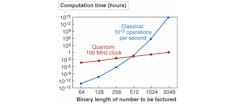IBM and Fraunhofer-Gesellschaft team up to promote quantum computing in Europe
IBM (NYSE: IBM) and the Fraunhofer-Gesellschaft (Munich, Germany) will set up a partnership to advance research in the field of quantum computing. The aim of this cooperation is to develop expertise and new strategies for the use of quantum computing in industry and for applied processes.
Under the terms of the joint initiative, an IBM Q System One quantum computer is to be installed at a German location. It will be the first facility of its kind in Europe. The IBM Q System One is designed to perform multi-qubit operations to an extremely high level of quality, stability, reliability and reproducibility. These factors and the resultant large quantum volume (a measure of the power of a quantum computer) mean that the IBM Q System One is well-suited for state-of-the-art research into concrete quantum-computing applications in science and industry.
Quantum computing has the potential to deliver the power required to analyze complex systems of business and industry, to disentangle convoluted interdependencies in molecular and chemical reactions, to master complex optimization problems, and to significantly increase the performance of artificial intelligence. Such advances could open the door to new scientific discoveries and deliver enormous improvements in supply-chain management, logistics, and the modeling of financial data and data for classic engineering problems.
The German federal government will invest 650 million euros over the next two years to promote the advance of quantum technology from basic research to market-ready applications. The establishment of the Fraunhofer Center for Quantum Computing is in accordance with the objectives of the federal government’s framework program. At the same time, it will provide the IBM Q Network with a major European hub for quantum computing. The focus here will be on achieving a unique concentration of quantum skills in Germany and building a community of researchers, developers, IT professionals, and industry experts in this field.
The joint initiative between the Fraunhofer-Gesellschaft and IBM will bring together prominent partners from research and industry under the common roof of a new Fraunhofer competence center for quantum computing. To be known as the Fraunhofer Center for Quantum Computing, the facility will be operated and managed by the Fraunhofer-Gesellschaft, which already conducts research throughout the field of quantum technology at 14 of its institutes.
“Quantum technology is set to have a major impact on Germany’s future, in both the scientific and economic sphere,” says Germany’s Federal Minister of Education and Research, Anja Karliczek. “Last year, the Federal Government therefore launched the program ‘Quantum technology: from basic principles to market applications’, which provides a clearly defined framework for action. Federal funds of 650 million euros will be invested in research and the development of quantum technology over the period until 2022. Fraunhofer-Gesellschaft’s collaboration with IBM in the field of quantum computing can make an important contribution to the realization of this program. It is vital that we now begin developing various fields of application for quantum computing, not least for small and medium-sized companies, which play a significant role in the German economy.”
“Bavaria will get a quantum computer—that is, a computer that is very much faster than any of the current generation,” says the Bavarian Minister of Economic Affairs, Regional Development and Energy, Hubert Aiwanger.
Participating companies will have access to IBM's advanced quantum systems via the IBM Cloud. Experts from industry and research require new skills and knowhow in order to capitalize on quantum computing;as part of the IBM Q Network, companies will therefore receive support and training from specialists at IBM.
About the Author
John Wallace
Senior Technical Editor (1998-2022)
John Wallace was with Laser Focus World for nearly 25 years, retiring in late June 2022. He obtained a bachelor's degree in mechanical engineering and physics at Rutgers University and a master's in optical engineering at the University of Rochester. Before becoming an editor, John worked as an engineer at RCA, Exxon, Eastman Kodak, and GCA Corporation.

